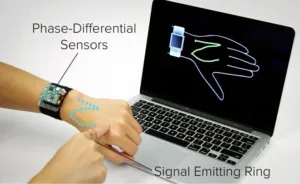If you own a smartwatch, it is quite possible that there have been occasions when you encountered difficulty in using touch to manipulate the physically small items on the display screen. A team at the Future Interfaces Group (Pittsburgh, PA), a part of the Human-Computer Interaction Institute which, in turn, is a research lab within Carnegie Mellon’s School of Computer Science, is developing an innovative means to address this issue. Their approach is based on making the skin on the user’s arm and hand act like an auxiliary smartwatch touchscreen.

The so-called SkinTrack device just made its public debut with the presentation of a paper on the technology at ACM CHI 2016. This is the Association for Computing Machinery’s Computer Human Interaction conference recently held in San Jose, California.
The SkinTrack system consists of two parts. The first is a signal-emitting ring that is worn on one of the user’s fingers, the finger being on the hand not wearing the smartwatch. The ring communicates to the second part of the system which is a sensing band that is attached to the watch and worn on the user’s wrist.
When the finger wearing the ring touches the skin on the user’s watch bearing arm, a high frequency electrical signal is emitted. This signal spreads across the user’s arm. The system uses the distance between the ring and electrodes in the watchband to triangulate the position of the user’s finger in 2D space. To accomplish this, two of the electrodes are oriented for X axis detection while two other electrodes are oriented for Y axis detection.
In a sense, the SkinTrack system works in a manner similar to the way that cell phone towers triangulate signals to determine the location of a user’s smartphone. In tests, the researchers report that SkinTrack to was able to accurately determine when the user’s finger was on the skin 99% of the time.
The researchers commented on concerns relating to the fact that the system sends electrical signals into the user’s arm. They report that there is no evidence to suggest that the radio frequency signals used by SkinTrack have any health effects.
One important challenge in creating a user-worn input device is that it not be obtrusive. The creators of SkinTrack claim that their approach successfully address this issue because watches and rings are already items worn by many people.
The SkinTrack system is capable of detecting various types of touch input.
Some of the types of input that can be detected by SkinTrack are of a conventional nature. One example of this is the ability to sense a continuous stroke. This would allow the user, for example, to draw a simple picture. A second example is the ability to sense discrete touch gestures like swipes or taps.
The SkinTrack system can also support other and arguably more interesting touch input possibilities.
The user can drag apps off the smartwatch and place them at a location on their arm. By this means, it is possible to create shortcuts back to the app which can be quickly accessed with a finger tap at the defined location. A second example is that the system can also be configured to recognize hot key commands. Examples of this include tracing an “N” on your hand to open up a news app or an “S” to silence a phone call.
The skin touch screen and the smartwatch touch screen can be programmed to “collaborate,” indicating different versions of an input command. As an example, a swipe on the smartwatch touch screen could initiate a slow scroll through an address book while a swipe on the skin touch screen could initiate a rapid scroll.
The system also includes an application that enables users to use the back of their hand as a dial pad. This would allow the user to use the skin touch screen to enter numbers and make phone calls.
A video discussing SkinTrack technology and illustrating the system in operation can be found at the end of this article.
The researchers point out that SkinTrack technology can follow the user’s finger even when it is hovering just above their arm. More than that, the system is reported to work even when the user’s skin is covered with clothing.
Since the SkinTrack system presented at the ACM CHI 2016 conference was still a prototype, it is not surprising to learn that there are still features of the system that need to be further perfected. The researchers report that “keeping the ring powered up is a challenge. Signals also tend to change as the device is worn for long periods, thanks to factors such as sweat and hydration and the fact the body is in constant motion.”
These seem to be solvable technical problems. Assuming they are solved and given that the SkinTrack system seems to be a valid solution to a real problem, commercial adoption would appear to be a realistic possibility. Nonetheless, at this time, no plan has been put forth to commercialize SkinTrack technology. -Arthur Berman
Future Interfaces Group, Yang Zhang, 412-330-8667, [email protected]

